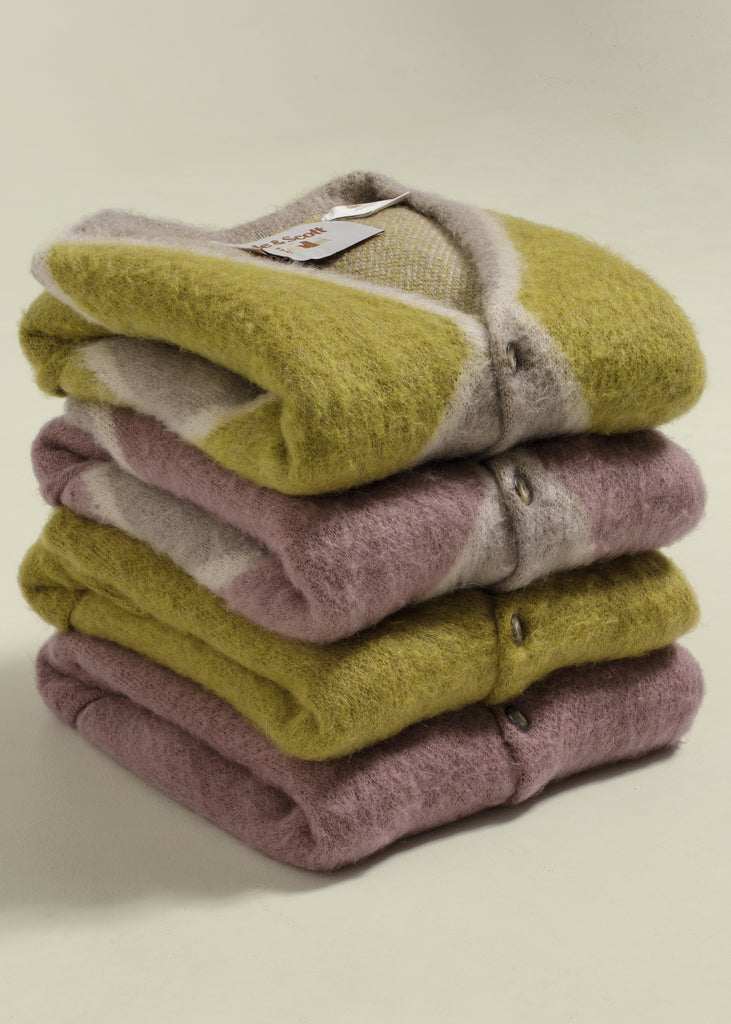
We’ve worked with the Scottish knitwear maestros at Lyle & Scott to make some particularly swanky argyle cardigans. Taking influence from the laid-back thrift-store stylings of Kurt Cobain, vintage Seditionaries jumpers and the relaxing sport of golf, it’s a super-shaggy slice of knitwear, made in Italy from soft and luscious mohair.
These beauties go online at 10:00am (GMT) on Thursday the 3rd December, but until then, here’s a quick chat with Oi Polloi founder Steve Sanderson about the cardigans, Lyle & Scott and the prevalence of golf gear in the 80s…
What’s going on with these cardigans then? What’s the story behind them?
The idea for the cardigans came from looking through images of the Lyle & Scott archive—we noticed these golf sweaters with oversized argyle patterns. The argyle looked great, but the colour pallet wasn't so good, so we came up with something that had a more organic feel, in a natural, earthy pallet.
The choice of mohair instead of wool sets them apart too.
We wanted to make something a little unexpected, inspired by their rich golfing heritage but added our own cultural references—we'd never seen Lyle & Scott do a mohair cardigan before. We wanted to make mohair cardigans that were affordable, but not at the expense of losing quality. Lyle & Scott's product development team helped us turn that idea into a real thing—they found an amazing Italian factory that could make the cardigans.


We wanted to bring together Lyle & Scott's rich history with our perspective on the cultural history of reappropriation—referencing cardigan-wearing cultural icons through the decades. There was Hockney in the ‘60s… Lydon in the ‘70s… Cobain in the ‘90s.
Even outside of these iconic figures—the cardigan has been a part of some fairly niche subcultures.
There was a little post-punk cultural movement starting to germinate and spread at the back-end of the ‘70s. Depending on where you’re from, it would be known by more localized names and was later renamed by The Face magazine. It was working-class inner-city lads with wedged hair, wearing mohair jumpers, duffle coats and straight legged jeans. Later they started shopping in sports shops, wearing golf knitwear and mixing it up with Italian sportswear.
There’s no golden eagle badge on them—was that a conscious decision?
We had the golden eagle etched into the buttons, but we kept the branding discreet on the outside—this was a nod to Lyle & Scott working with, and making for, Dior in the ‘50s. We wanted the quality of the item to be the thing you notice.


Lyle & Scott are one of the earliest Scottish knitwear companies—their history that goes back to 1874. It’s safe to say that they’re a well-established, specialist maker… whereas we, on the other hand, started in 2002. Lyle & Scott was one of the first labels we stocked.
What do you remember about Lyle and Scott growing up in Greater Manchester?
We grew up when a sports shop was a sports shop. They sold sporting goods—everything from cricket bats and tennis rackets to football boots—whatever you needed, they sold it. There was a shop called Hurley's Sport & Golf shop—the clue was in the name. For us it was all about tennis and golf, expensive Italian and French tennis tracksuits and classic British golfing gear, like lambswool crew-neck sweaters a V-neck Argyles worn over a roll neck. I’m pretty sure we never would have been let loose on a golf course.

A lot of golf gear sort of crossed over into casual-wear in the late 70s and early 80s. Why do you reckon that was? What do you think was the appeal of this fairly classic, unassuming stuff?
The appeal was that it was your thing—if you were into it. You knew and other people didn't know what was going on—it was in clear sight, yet invisible all at once. Any cultural movement, especially of this tribal type, is an intoxicating thing.
If you think about what else was going on at the time, people were wearing almost a fancy-dress costume to be part of a thing, whereas this was dressing to blend in and not be noticed. It was the reappropriation of products and brands that shouldn't have been worn by us. We were taking ideas from the landed gentry and their outdoor pursuit lifestyles, and the middle classes with their golf and tennis clubs. Working class kids were turning it on its head.


How important were the local sports shops in all of this? It seems like they were the main places to get interesting clothes back then.
The evolution of the working-class wardrobe—the stuff we were into then—still influences what we’re into today. Sports shops and outdoor pursuit shops were all very important, everything back then was separated. You did have gentlemen's outfitters, but that was more your trad, classic menswear. Sportswear and utilitarian design is a massive part of what we do today— that passion for clothes and quality never leaves, but I'm not a fan of dressing like you’re from a different time. You’ve got to take what is current and relevant today and blend it together with classic elements. I'm a modernist at heart, quality is the thing I appreciate the most.

The Lyle & Scott Cardigans will be available from 10:00am (GMT) on Thursday the 3rd December.